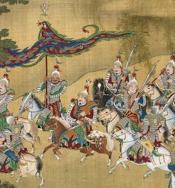Upon assuming the throne of the Ming dynasty in 1403, the Yongle emperor initiated an ambitious project of government horse rearing. Scouts were first sent to find suitable pastureland along China’s northern frontier. And between 1406–1408 four pasturage offices were established in Gansu, Shaanxi, Beijing, and Liaodong. They presided over a network of ranches that raised between 4,000 and 10,000 horses each. According to official reports, within twenty years the number of government horses rose from 38,000 to over a million and a half stallions, mares, and colts.
This research project explores geographical, military, and economic aspects of this remarkable achievement. It aims to identify the location of ranches and place them within the larger geographical context of civilian and military settlements, geographical features, and environmental conditions. Furthermore, it examines administrative aspects of government horse rearing such as manpower, funding, and cooperation with other administrative agencies, namely provincial military headquarters and government horse purchasing agencies. Illuminating this little-known institution will contribute to our understanding of early Ming military might.


